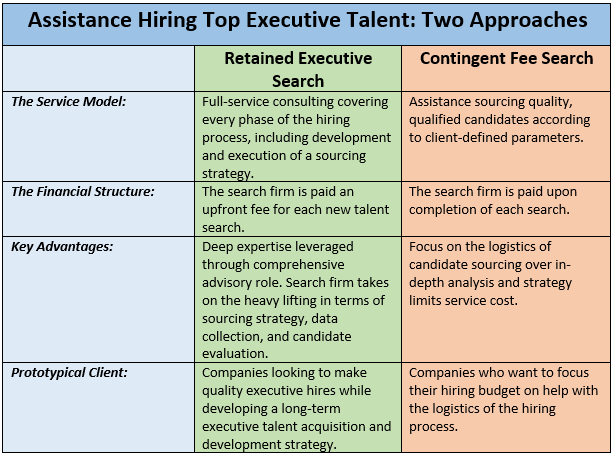Retained search is a process where an organization retains the services of an executive search firm to find and recruit both active and passive candidates for senior-level positions within the company. It can be a costly and time-consuming process, and there are many potential challenges that can arise. In this article, we will explore a few of the challenges and alternatives to retained executive search.
Contents
What is retained search?
Retained search is a process where an organization retains the services of an executive search firm to find and recruit candidates for senior-level positions within the company.
When an executive search firm is on “retainer” they are typically paid a portion of their engagement fee up-front. This helps to commit both the retained search agency as well as the corporate client looking to place a top position within their company or portfolio company.
What is the difference between retained search and contingency search?
Unlike retained search, a contingency search firm is only paid upon the successful completion of an engagement to find a particular placement for a given role.

For instance, a retained search firm may have a percentage based or flat fee that amounts to somewhere in the range of $90,000 to find and place a new role for a CFO or other financial services executive.
In the case of a retained firm, they may require an up-front or monthly retainer that equates to the equivalent of up to half of the total placement fee as a retainer for using their sourcing process and network to find the best top talent for their open role.
In this example, they would pay $45,000 up front and the second $45,000 check once the placement has been made, presumably within a few weeks to a few months, depending on the role’s need.
Why is retained search used?
There are many reasons why an organization might opt to use retained search instead of contingency search. Despite the challenges, retained search can offer many benefits to organizations, some of which include:
- A higher success rate: Because retained recruiting firms are dedicated to finding the right candidate for the position, they have a higher success rate than contingency search firms.
- Access to a larger pool of candidates: Executive search firms have access to a larger pool of potential candidates than most organizations.
- A dedicated team: Retained search agencies have a dedicated team of professionals working on finding the right candidate for the organization. The ability to have a dedicated team of professionals working on finding the right candidate for the position can be extremely beneficial. Focus is always critical rather than using shotgun approach.
The “retained” executive search process
The process of retained search typically involves the following steps:
- Defining the position. When retained search is initiated, the first step is to define the position. This includes understanding the responsibilities of the role, the skills and experience required, and the ideal candidate profile. Having a clear understanding of what is needed will help to ensure that the search process is more efficient and focused.
- Identifying the ideal candidate. Once the position has been defined, the next step is to identify the ideal candidate. This includes defining the skills, experience, and qualifications that are required for the role. The ideal candidate profile will help to focus the search and ensure that only qualified candidates are considered.
- Conducting a search. The next step in retained search is to conduct a search for qualified candidates. This can be done in several ways, including:
- Using a retained search firm: A retained search firm can help to identify and recruit qualified candidates for the position. They have access to a large pool of potential candidates and they are dedicated to finding the right candidate for the role.
- Advertising the position: Organizations can advertise the position online or in newspapers and other media outlets. This can help to attract qualified candidates from across the country or even the world.
- Networking: Networking with friends, family, and colleagues can help to identify potential candidates for the role.
- Recruiting the candidate. Once a qualified candidate has been identified, the next step is to recruit them for the role. This can be done in several ways, including:
- Contacting the candidate directly: The retained recruiting firm can contact the candidate directly and arrange a meeting or interview.
- Arranging an interview with the hiring manager: The hiring manager can meet with the candidate for an interview to assess their qualifications and fit within the role as well as company culture.
- Conducting a reference check: The retained staffing firm can conduct a reference check with the candidate’s former employers to assess their skills and experience.
- Recruiting the candidate: The retained search firm can work with the hiring managers within the organization to help them recruit the best candidate for the role.
- Negotiating the offer. Once the candidate has been recruited, the next step is to negotiate an offer with them. This can be a challenging process, but it is important to ensure that the offer is fair and reasonable. The retained search firm can help to negotiate an offer that is favorable to both the organization and the candidate.
- Closing the deal. The last step is to sign the candidate and relocate (where necessary).
The challenges of retained search
There are many potential challenges that can arise during retained search, some of which include:
The cost
Retained search can be a costly process, and it may not be feasible for all organizations. The upfront cost can be a deterrent for some organizations, and the monthly retainer can add up quickly, especially for smaller organizations that need to play within a very strict budget for their open role.
Time-consuming
Retained search can also be a time-consuming process, which may not be ideal for organizations that need to fill a position quickly. The search process can take several weeks or even months, depending on the role and the number of candidates that need to be interviewed.
There is no guarantee of success
Another potential challenge with retained search is that there is no guarantee of success. Even though retained search firms typically have a higher success rate than contingency search firms, there is still no guarantee that the right candidate will be found and recruited for the position.
Difficult to find the right firm
There are many executive search firms to choose from, and it can be difficult to find the right one for the organization.
Replacing a retained search firm
If the retained recruiting firm is not meeting the expectations of the organization, it can be difficult and costly to replace them.
How to overcome the challenges of retained search
There are several ways that organizations can overcome the challenges of retained search, some of which include:
- Use a contingency search instead of retained executive search if time or money is tight.
- Work with a reputable firm. It is important to work with a reputable retained firm that has a proven track record of success.
- Increase the budget for retained executive searches if more time is available. Organizations should be prepared for the cost and time commitment involved in retained search.
- Broaden the job criteria requirements to increase the number of potential candidates.
- Better define the position. Organizations should take the time to define the requirements for the position and the ideal candidate, so that the retained executive search firm has a clear understanding of what is needed.
- Use social media and other online job search database resources to identify potential candidates.
Conclusion
Retained executive search can be a costly and time-consuming process, but it can offer many benefits to organizations. It is important to work with a reputable retained search firm and to be prepared for the cost and time commitment involved. Organizations should also take the time to define the requirements for the position and the ideal candidate.
Are you looking for assistance in establishing your C-suite succession plan from a top recruitment firm? Contact us today for a free consultation.

Ryan is an experienced executive search and sourcing professional. He has worked as a high-performing recruiter for more than a decade, sourcing top talent for some of the most reputable companies in the world. He resides in Texas with his wife and three children.


